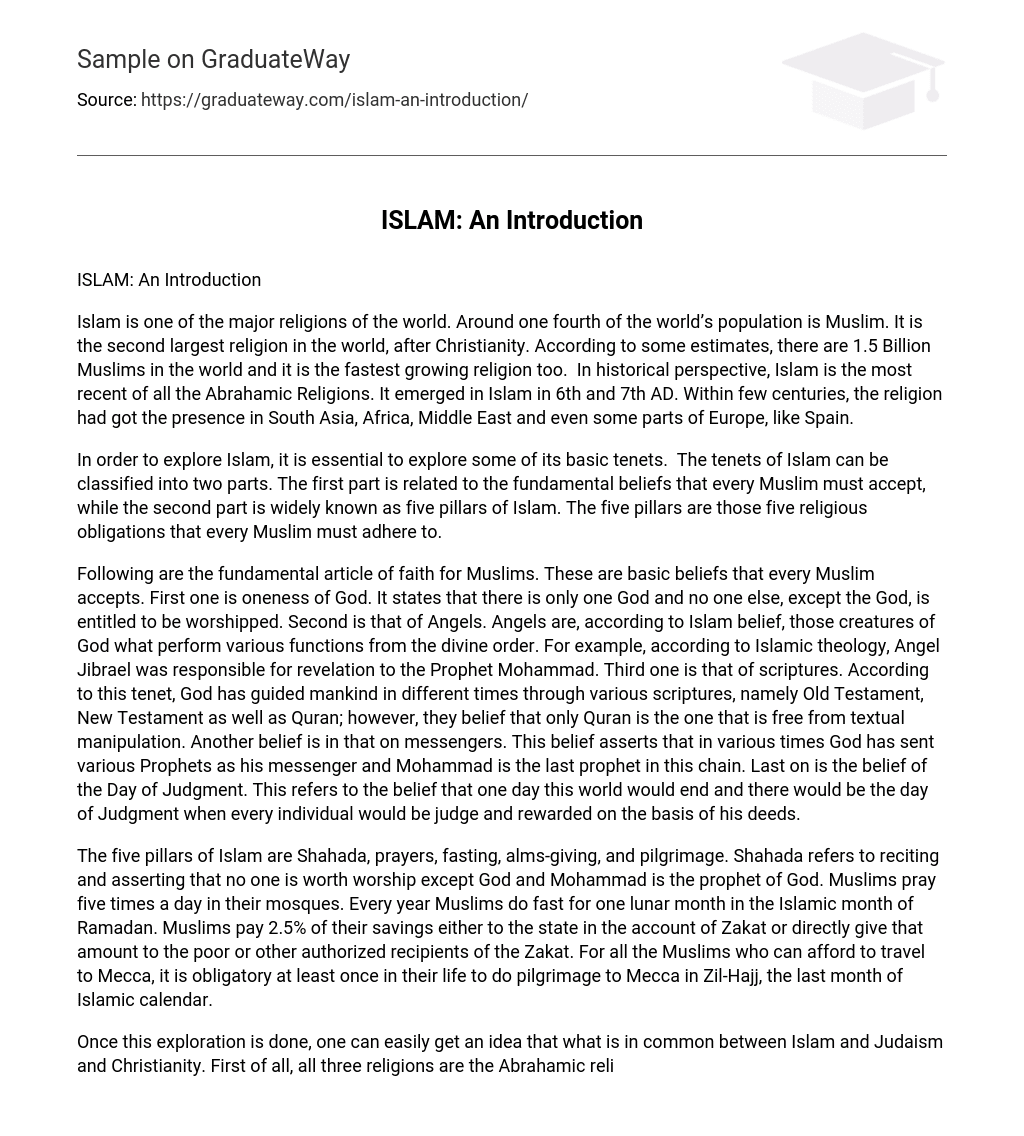Islam is one of the major religions of the world. Around one fourth of the world’s population is Muslim. It is the second largest religion in the world, after Christianity. According to some estimates, there are 1.5 Billion Muslims in the world and it is the fastest growing religion too. In historical perspective, Islam is the most recent of all the Abrahamic Religions. It emerged in Islam in 6th and 7th AD. Within few centuries, the religion had got the presence in South Asia, Africa, Middle East and even some parts of Europe, like Spain.
In order to explore Islam, it is essential to explore some of its basic tenets. The tenets of Islam can be classified into two parts. The first part is related to the fundamental beliefs that every Muslim must accept, while the second part is widely known as five pillars of Islam. The five pillars are those five religious obligations that every Muslim must adhere to.
Following are the fundamental article of faith for Muslims. These are basic beliefs that every Muslim accepts. First one is oneness of God. It states that there is only one God and no one else, except the God, is entitled to be worshipped. Second is that of Angels. Angels are, according to Islam belief, those creatures of God what perform various functions from the divine order. For example, according to Islamic theology, Angel Jibrael was responsible for revelation to the Prophet Mohammad. Third one is that of scriptures. According to this tenet, God has guided mankind in different times through various scriptures, namely Old Testament, New Testament as well as Quran; however, they belief that only Quran is the one that is free from textual manipulation. Another belief is in that on messengers. This belief asserts that in various times God has sent various Prophets as his messenger and Mohammad is the last prophet in this chain. Last on is the belief of the Day of Judgment. This refers to the belief that one day this world would end and there would be the day of Judgment when every individual would be judge and rewarded on the basis of his deeds.
The five pillars of Islam are Shahada, prayers, fasting, alms-giving, and pilgrimage. Shahada refers to reciting and asserting that no one is worth worship except God and Mohammad is the prophet of God. Muslims pray five times a day in their mosques. Every year Muslims do fast for one lunar month in the Islamic month of Ramadan. Muslims pay 2.5% of their savings either to the state in the account of Zakat or directly give that amount to the poor or other authorized recipients of the Zakat. For all the Muslims who can afford to travel to Mecca, it is obligatory at least once in their life to do pilgrimage to Mecca in Zil-Hajj, the last month of Islamic calendar.
Once this exploration is done, one can easily get an idea that what is in common between Islam and Judaism and Christianity. First of all, all three religions are the Abrahamic religions, which mean that the figureheads of all these religions (Prophet Mohammad, Jesus, and Moses) have Prophet Abraham in common their genealogies. Secondly, all three believe in the existence of God and the concept of Angels and Divine Scriptures as well as prophets being the messengers of God. However, the other two do not accept Mohammad as the prophet of God and Quran being the divine scripture. Thus, we can say that three religions have common conceptual foundations. They do differ, in majority cases, on explanation of those beliefs. Practices however differ greatly. The three also have the practice of fasting in common, but with varying formats.
The faith of Islam is now very widespread. It touched the three continents, Asia, Africa and Europe in just few centuries of its emergence. By the death of Holy Prophet, Islam was primarily restricted to Arab territories like Mecca, Medina and some other adjacent areas. However, after his death, the patriarch Caliphs worked on the expansion of Islamic borders which in the time of Umer, the third Caliph reached its zenith. In his reign Muslims had entered the border of Persia. Later on, when Umayyad Dynasty was in rule, Mohammad bin Qasim entered Sindh, the South Asian province. Likewise, during their reign, Muslims had also entered Central Asian and Africa. Africa was then fully conquered by the Fatimid Dynasty and in Europe Spain became the centre of learning and a reflection of Muslim civilization. Later on, the Umayyad king Abdur Rehman fled there and established his reign. Political expansion was one of the most common ways of the spread of Islam. Besides, there were Arab traders who went to different areas and preachers Islam there. Another mode of the spread of Islam was the religion scholars or saints who travelled to different areas, especially in Persia, Central Asia and Hindustan.
To sum up, Islam is one of the major religions of world and has many things in common with Judaism and Christianity and if people focus more on the common things and accepts diversity, the world would be a better and peaceful place to live.
WORKS CITED
Armstrong, Karen. Islam: A Short History (Modern Library Chronicles). New York: Modern Library, 2002.
Caner, Ergun Mehmet. Unveiling Islam: An Insider’s Look at Muslim Life and Beliefs. Grand Rapids, MI: Kregel Publications, 2002.
Hodgson, Marshall G. S.. Venture of Islam: Conscience and History in a World Civilization The Expansion of Islam in the Middle Periods. Chicago: Univ Of Chicago Pr, 1977.
;





